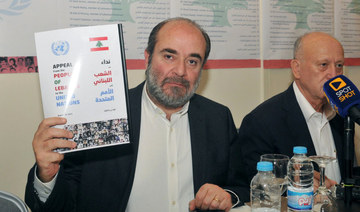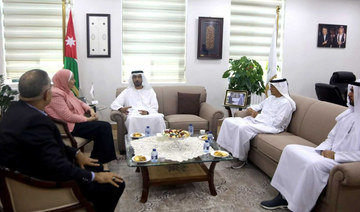BEIRUT: Anti-government protests in southern Syria have entered their second week, with demonstrators waving the colorful flag of the minority Druze community, burning banners of President Bashar Assad and at one point raiding several offices of his ruling party.
The protests were initially driven by surging inflation and the war-torn country’s spiraling economy, but quickly shifted focus, with marchers calling for the fall of the Assad government.
The protests have been centered in the government-controlled province of Sweida, the heartland of Syria’s Druze, who had largely stayed on the sidelines during the long-running conflict between Assad and those trying to topple him.
In a scene that once would have been unthinkable in the Druze stronghold, protesters kicked members of Assad’s Baath party out of some of their offices, welded the doors shut and spray-painted anti-government slogans on the walls.
The protests have rattled the Assad government, but don’t seem to pose an existential threat. They come at a time when government forces have consolidated their control over most of the country and Damascus has returned to the Arab fold and restored ties with most governments in the region.
Still, anger is building, even among Syrians who did not join the initial anti-Assad protests in 2011 that were met by a harsh crackdown and plunged the country into years of civil war.
For some, the final straw came two weeks ago when the Syrian president further scaled back the country’s expensive fuel and gasoline subsidy program. A simultaneous doubling of meager public sector wages and pensions did little to cushion the blow, as it accelerated inflation and further weakened the Syrian pound, further piling the pressure on millions living in poverty.
Soon after, protests kicked off in the provinces of Sweida and the neighboring province of Daraa.
Over the past decade, Sweida had largely isolated itself from Syria’s uprising turned-conflict although it witnessed sporadic protests decrying corruption and the country’s economic backslide. This time, crowds quickly swelled into the hundreds, calling out political repression by Assad’s government, in an echo of protests that rocked the country in 2011.
“People have reached a point where they can no longer withstand the situation,” Rayan Maarouf, editor-in-chief of the local activist media collective Suwayda24, told The Associated Press. “Everything is crumbling.”
While Assad’s political fortunes have been on the rise in recent months, life for much of the country’s population has become increasingly miserable. At least 300,000 civilians have been killed in the conflict, half of Syria’s prewar population of 23 million has been displaced and large parts of the infrastructure have been crippled. Ninety percent of Syrians live in poverty. Rampant corruption and Western-led sanctions have also worsened poverty and inflation.
In Daraa, often referred to as the birthplace of the 2011 uprising but now under government control, at least 57 people were arrested in the current protests, according to the Britain-based Syrian Network for Human Rights. Unlike in 2011, government forces did not use lethal force.
In Sweida, the response has been more restrained, with Assad apparently wary of exerting too much force against the Druze. During the years of civil war, his government presented itself as a defender of religious minorities against Islamist extremism.
Over the years, the province’s young men have also armed themselves to defend their villages from Daesh militants and Damascus-associated militias that produce and trade in illegal amphetamine pills, known as Captagon.
Joseph Daher, a Swiss-Syrian researcher and professor at the European University Institute in Florence, believes that this provides a layer of protection for protesters.
“Unlike other government-held areas, Sweida has some form of limited autonomy,” Daher said.
Meanwhile, in Damascus, Lattakia, Tartous and other urban government strongholds, some are voicing their discontent more quietly. They write messages of support for the protests on paper, take pictures of those notes on the streets of their towns, and share them on social media.
Others suffer in silence and focus on daily survival. In Damascus, some have taken to carrying backpacks instead of wallets to carry the wads of cash they need to make everyday purchases amid the rampant inflation, while families struggle to buy basic necessities.
“If I buy (my son) two containers of milk, I’d have spent my entire month’s salary,” Damascus resident Ghaswan Al-Wadi told the AP while preparing her family dinner at home after a long day at work.
The ongoing protests highlight Assad’s vulnerability as a result of the failing economy, even in areas without widespread ideologically driven opposition to his continued rule, such as Sweida.
Could the protests eventually threaten his rule?
Daher said this could only happen if the protesters banded together.
“You have forms of solidarity from other cities (with Sweida),” Daher said. “But you can’t say it would have a real effect on the regime, unless there would be collaboration between (protesters in) different cities.”
Syria protests spurred by economic misery stir memories of the 2011 anti-government uprising
https://arab.news/mf7vh
Syria protests spurred by economic misery stir memories of the 2011 anti-government uprising
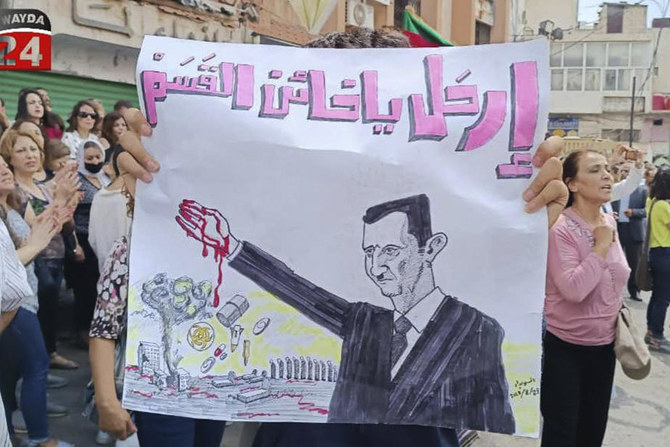
- The protests have been centered in the government-controlled province of Sweida
- The protests were initially driven by surging inflation and the war-torn country’s spiraling economy, but quickly shifted focus, with marchers calling for the fall of the Assad government
Fierce fighting in northern Gaza as aid starts to roll off US-built pier

- Residents said Israeli bulldozers were demolishing homes and shops in Jabalia in the path of the advance
- In the south, Palestinian militants put up a fierce resistance, attacking tanks massing around Rafah
- Hamas says US floating aid pier is no substitute for end of Israeli siege of Gaza
CAIRO: Israeli forces battled Hamas fighters in the narrow alleyways of Jabalia in northern Gaza on Friday in some of the fiercest engagements since they returned to the area a week ago, while in the south militants attacked tanks massing around Rafah.
Residents said Israeli armor had thrust as far as the market at the heart of Jabalia, the largest of Gaza’s eight historic refugee camps, and that bulldozers were demolishing homes and shops in the path of the advance.
“Tanks and planes are wiping out residential districts and markets, shops, restaurants, everything. It is all happening before the one-eyed world,” Ayman Rajab, a resident of western Jabalia, said via a chat app.
Israel had said its forces cleared Jabalia months earlier in the Gaza war, triggered by the deadly Hamas-led attacks on southern Israel on Oct. 7, but said last week it was returning to prevent Islamist militants re-grouping there.
In southern Gaza bordering Egypt, thick smoke rose over Rafah, where an escalating Israeli assault has sent hundreds of thousands of people fleeing from what was one of the few remaining places of refuge.
“People are terrified and they’re trying to get away,” Jens Laerke, UN humanitarian office spokesperson, said in Geneva, adding that most were following orders to move north toward the coast but that there were no safe routes or destinations.
As the fighting raged, the US military said trucks started moving aid ashore from a temporary pier, the first to reach the besieged enclave by sea in weeks.
The World Food Programme, which expects food, water, shelter and medical supplies to arrive through the floating dock, said the aid was transported to its warehouses in Deir Al Balah in central Gaza and told partners it was ready for distribution.
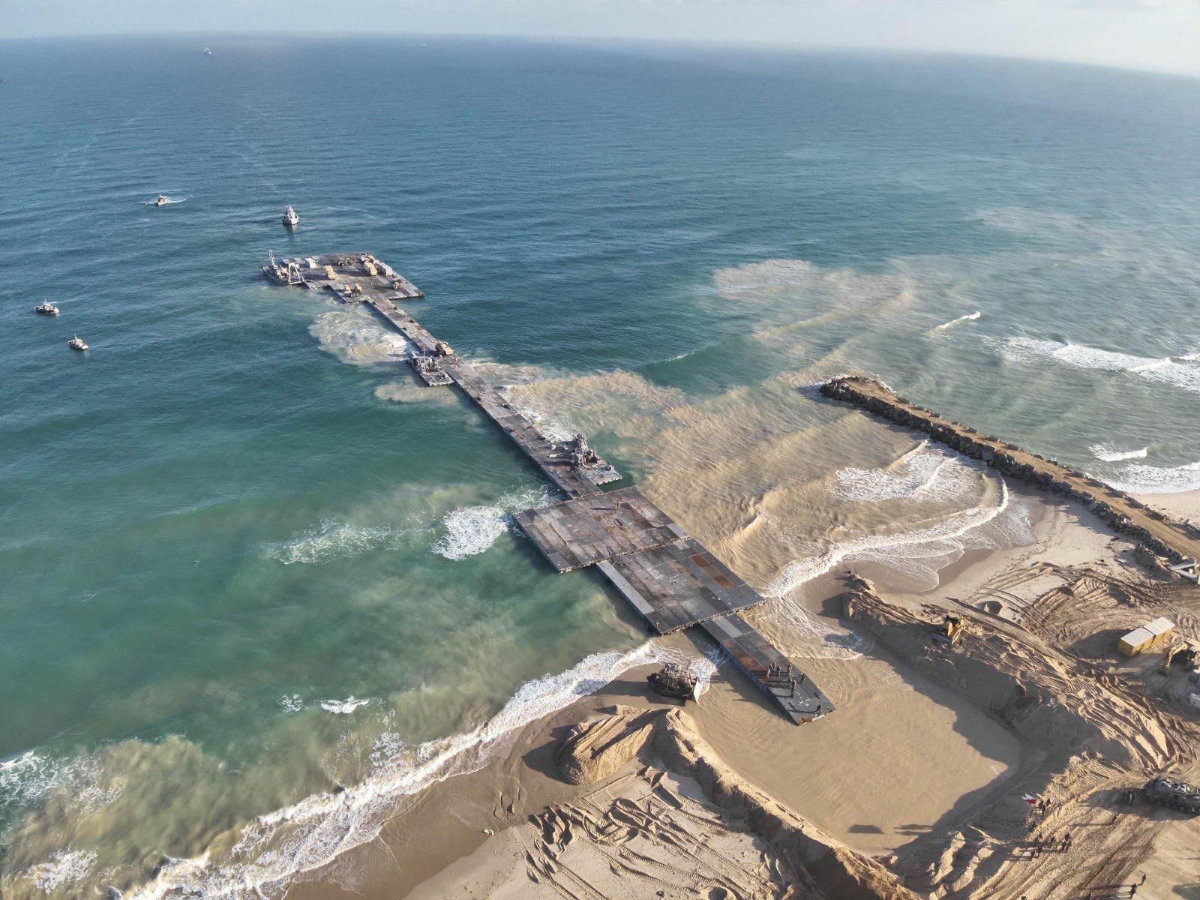
The United Nations earlier reiterated that truck convoys by land — disrupted this month by the assault on Rafah — were still the most efficient way of getting aid in.
“To stave off the horrors of famine, we must use the fastest and most obvious route to reach the people of Gaza – and for that, we need access by land now,” deputy UN spokesperson Farhan Haq said.
US aid was arriving in Cyprus for delivery to Gaza via the new pier, Washington said.
Hamas demanded an end to Israel’s siege and accused Washington of complicity with an Israeli policy of “starvation and blockade.”
The White House said US national security adviser Jake Sullivan would visit Israel on Sunday and stress the need for a targeted offensive against Hamas militants rather than a full-scale assault on Rafah.
A group of US medical workers left the Gaza Strip after getting stuck at the hospital where they were providing care, the White House said.
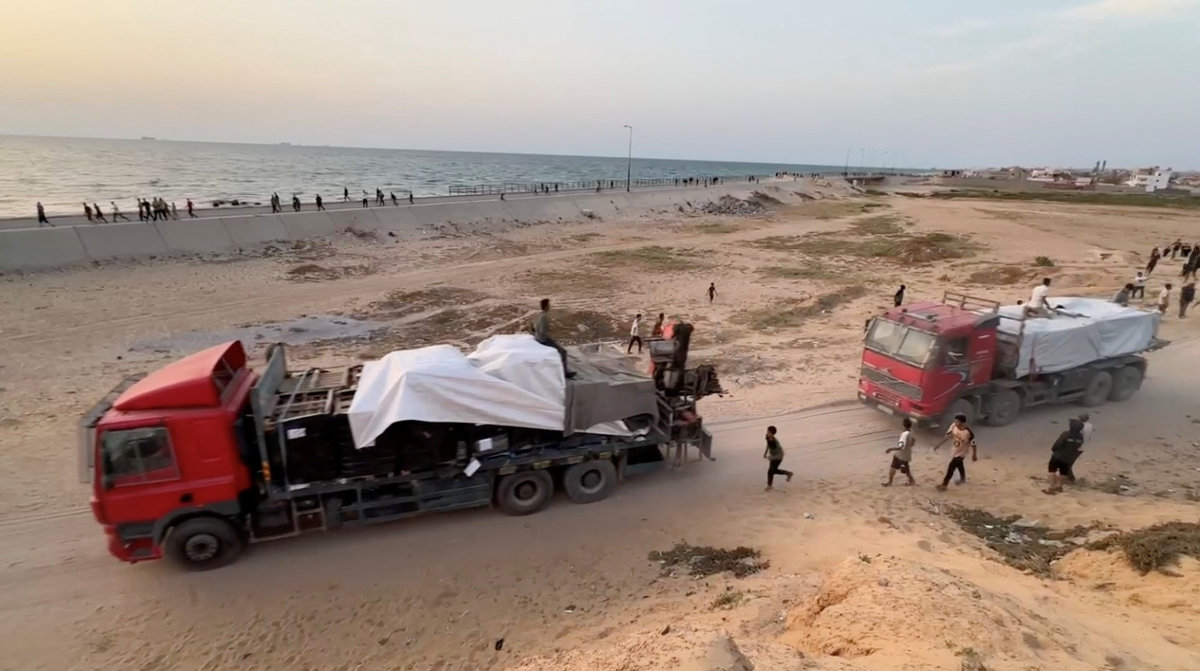
Humanitarian fears
The Israel Defense Forces said troops killed more than 60 militants in Jabalia in recent days and located a weapons warehouse in a “divisional-level offensive.”
A divisional operation would typically involve several brigades of thousands of troops each, making it one of the biggest of the war.
“The 7th Brigade’s fire control center directed dozens of airstrikes, eliminated terrorists and destroyed terrorist infrastructure,” the IDF said.
At least 35,303 Palestinians have now been killed, according to figures from the enclave’s health ministry, while aid agencies have warned repeatedly of widespread hunger and dire shortages of fuel and medical supplies.
Israel says it must capture Rafah to destroy Hamas and ensure the country’s safety. In the Hamas attack on Oct. 7, 1,200 people died in Israel and 253 were taken hostage, according to Israeli tallies. About 128 hostages are still being held in Gaza.
Israel said on Friday that its forces retrieved the bodies of three people killed at the Nova music festival in Israel on Oct. 7 and taken into Gaza.
In response, Hamas said negotiations were the only way for Israel to retrieve hostages alive: “The enemy will not get its prisoners except as lifeless corpses or through an honorable exchange deal for our people and our resistance.”
Talks on a ceasefire have been at an impasse.
’Tragic war’
Israeli tanks and warplanes bombarded parts of Rafah on Friday, while the armed wings of Hamas and Islamic Jihad said they fired anti-tank missiles and mortars at forces massing to the east, southeast and inside the Rafah border crossing with Egypt.
UNRWA, the main UN aid agency for Palestinians, said more than 630,000 people had fled Rafah since the offensive began on May 6.
“They’re moving to areas where there is no water — we’ve got to truck it in — and people aren’t getting enough food,” Sam Rose, director of planning at UNRWA, told Reuters on Friday by telephone from Rafah, where he said it was eerily quiet.
At the International Court of Justice, or World Court, in The Hague, where South Africa has accused Israel of violating the Genocide Convention, Israeli Justice Ministry official Gilad Noam defended the operation.
The South African legal team, which set out its case for fresh emergency measures the previous day, framed the Israeli military operation as part of a genocidal plan aimed at bringing about the destruction of the Palestinian people.
WHO says no medical supplies received in Gaza for 10 days

GENEVA: The World Health Organization said Friday that it has received no medical supplies in the Gaza Strip for 10 days as Israel pursues a new offensive against Hamas.
Israel’s closure of the Rafah crossing into Gaza has caused “a difficult situation,” WHO spokesman Tarik Jasarevic said. “The last medical supplies that we got in Gaza was before May 6.”
Israeli troops entered the city of Rafah on May 7 to extend their offensive against Hamas over the militant group’s attacks seven months earlier. They closed the Rafah crossing into Egypt that is crucial for humanitarian supplies.
With UN agencies warning of a growing risk of famine in Gaza, the Kerem Shalom and Erez crossings from Israel are also virtually shut down.
Jasarevic said the biggest concern was over fuel needed to keep clinics and hospitals running. Gaza’s health facilities need up to 1.8 million liters of fuel a month to keep operating.
The spokesman said only 159,000 liters had entered Rafah since the border closure. “This is clearly not sufficient,” he added, highlighting how only 13 out of 36 hospitals across the Palestinian territory were now “partially” operating.
“Hospitals still functioning are running out of fuel, and that puts so many lives at danger,” said Jasarevic. “Current military operations in Rafah are putting countless lives at risk.”
The Hamas attack on October 7 resulted in the death of more than 1,170 people in Israel, most of them civilians, according to an AFP tally based on official Israeli figures. Out of 252 people taken hostage, 128 are still held inside Gaza, but the army says 38 have died.
More than 35,300 people, mostly civilians, have been killed in the Palestinian territory since the war broke out, according to data provided by the health ministry of Hamas-run Gaza.
Hezbollah uses new weapons in Israel attacks

- The Israeli army said three soldiers were wounded in an attack on Thursday
- Hezbollah has a large arsenal of weapons, that it has expanded significantly in recent years
BEIRUT: Lebanon’s powerful armed group Hezbollah announced on Thursday it had used a drone capable of firing rockets at a military position in one of its latest attacks in northern Israel.
Israel and Hezbollah have been involved in near-daily exchanges of fire since the war between Israel and Hamas broke out on October 7.
Hezbollah announced it had used an “armed attack drone” equipped with two S-5 rockets on a military position in Metula in northern Israel.
The Iran-backed group published a video showing the drone heading toward the position, where tanks were stationed, with the footage showing the moment the two rockets were released followed by the drone exploding.
It was the first time they had announced the use of this type of weapon since the cross-border exchanges with Israel erupted in October.
The Israeli army said three soldiers were wounded in Thursday’s attack.
Hezbollah-affiliated media said that the drone’s warhead consisted of between 25 and 30 kilogrammes (55 and 66 pounds) of high explosive.
Military analyst Khalil Helou told AFP that the use of drones offers Hezbollah the ability to launch the attack from within Israeli territory, as they can fly at low altitudes, evading detection by radar.
Hezbollah also announced on Wednesday that it had launched a strike using “attack drones” on a base west of the northern Israeli town of Tiberias.
That attack was the group’s deepest into Israeli territory since fighting flared, analysts said.
In recent weeks, the Lebanese militant group has announced attacks that it has described as “complex,” using attack drones and missiles to hit military positions, as well as troops and vehicles.
It has also used guided and heavy missiles, such as Iran’s Burkan and Almas missiles, as well as the Jihad Mughniyeh missile, named after a Hezbollah leader killed by Israeli fire in Syria in 2015.
Helou, a retired general, said that depite its new weaponry, Hezbollah still relied primarily on Kornet anti-tank missiles with a range of just five to eight kilometers.
They also use the Konkurs anti-tank missile, which can penetrate Israel’s Iron Dome defense system.
Hezbollah has a large arsenal of weapons, that it has expanded significantly in recent years.
The group has said repeatedly that it has advanced weapons capable of striking deep inside Israeli territory.
Analysts have described the skirmishes between Israel and Hamas as a war of “attrition,” in which each side is testing the other, as well as their own tactics.
Hezbollah has expanded the range of its attacks in response to strikes targeting its munitions and infrastructure, or its military commanders.
One such Israeli strike on Wednesday targeted the village of Brital in Lebanon’s eastern Bekaa Valley, with the Israeli army later announcing it had hit a “terror target related to Hezbollah’s precision missile project.”
Helou said Hezbollah’s targeting of the base near Tiberias and its use of the rocket-equipped drone “can be interpreted as a response to the attack on Brital, but it remains a shy response compared to the group’s capabilities.”
He suggested that the Israeli strike likely hit a depot for Iranian missiles that had not yet been used by Hezbollah.
“Hezbollah does not wish to expand the circle of the conflict,” Helou said.
“What is happening is a war of attrition through which it is trying to distract the Israeli army” from Gaza and seeking to prevent it from “launching a wide-ranging attack on Lebanon.”
US officials held indirect talks with Iran on avoiding regional escalation: report

Two top Biden administration officials held indirect talks with Iranian counterparts this week in an effort to avoid escalating regional attacks, Axios reported on Friday.
The conversations marked the first round of discussions between the US and Iran since January, according to Axios.
One Palestinian killed, eight wounded in Israeli strike on West Bank refugee camp

- Israel has killed more than 35,000 Palestinians, according to Gaza’s Health Ministry
RAMALLAH, West Bank: At least one person was killed and eight wounded on Friday in an Israeli air strike on the Jenin refugee camp in the occupied West Bank, the Palestinian health ministry and Israeli military said.
The Palestinian health ministry said the eight wounded people were in stable condition and receiving treatment at hospitals. Reuters could not immediately confirm their identities.
The Israeli military said a fighter jet conducted the strike, a rarity in the West Bank, where violence had been surging long before the Gaza war.
Residents of the refugee camp said a house was targeted.
The West Bank is among territories Israel occupied in a 1967 Middle East war. Palestinians want it to be the core of an independent Palestinian state.



